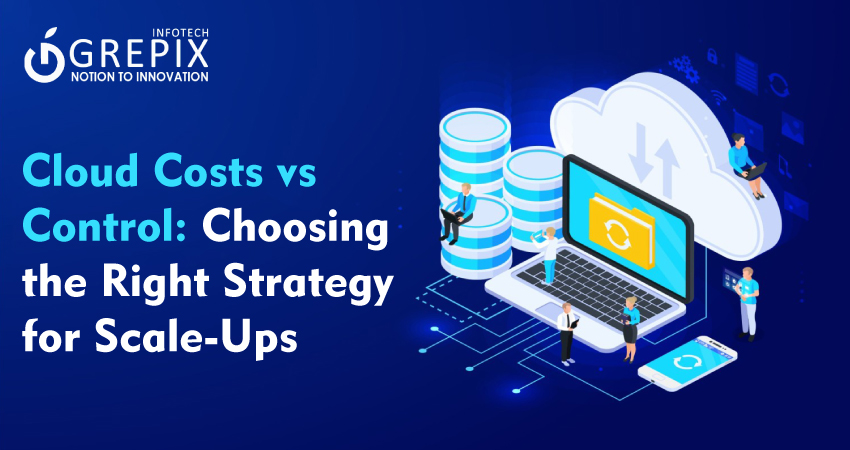Cloud Costs vs Control: Choosing the Right Strategy for Scale-Ups
Choosing between cloud costs and infrastructure control is a make or break decision for scale-ups. Cloud platforms offer speed, flexibility, and ease, but as you grow, the costs can soar. Moving to a hybrid or on-premise setup can offer long term savings and better control but it’s not for everyone. The right approach blends smart cloud use with strong governance, cost monitoring, and tech flexibility.
Choosing between cloud costs and infrastructure control is a make-or-break decision for scale-ups. Cloud platforms offer speed, flexibility, and ease, but as you grow, the costs can soar. Moving to a hybrid or on-premise setup can offer long-term savings and better control but it’s not for everyone. The right approach blends smart cloud use with strong governance, cost monitoring, and tech flexibility.
Scaling a business is an exciting journey. But when your company starts growing faster than a viral TikTok video, managing your tech stack becomes a real balancing act. One of the biggest decisions scale-ups face today is choosing between cloud convenience and infrastructure control.
Do you go all-in with cloud services for speed and flexibility? Or do you bring some infrastructure in-house to tighten control and reduce long-term costs?
Let’s break it down in a friendly, no-fluff way. Whether you're a tech founder in Lagos, a startup CTO in Berlin, or a product manager in Bangalore, this post will help you make sense of it all.
What Do We Mean by “Cloud Costs vs Control”?
When businesses grow, their infrastructure needs evolve. In the early days, most startups jump into the cloud it’s fast, affordable (at first), and gets you off the ground quickly.
But as your user base increases, so does your cloud bill.
At some point, companies begin to wonder: "Are we paying too much for convenience? Could we do better with more control?"
Let’s define the two ends of this spectrum:
- Cloud Convenience: Pay-as-you-go model. No physical server management. Fast deployments. Services like AWS, Azure, GCP, DigitalOcean.
- Infrastructure Control: Self-hosted or hybrid approach. Greater customization. More control over security, performance, and cost. Requires in-house DevOps or sysadmin expertise.
The Cloud: A Great Fit for Early Growth
When you’re starting out, cloud services are a dream. Here’s why so many scale-ups begin their journey here:
- Speed to Market: You can spin up servers in seconds. No need to worry about buying hardware or waiting on shipments. Just log in and go.
- Scalability: With tools like Kubernetes, Lambda functions, or serverless platforms, scaling up (or down) happens with a few clicks. Whether you're launching in Sydney or São Paulo, the cloud has your back.
- Lower Initial Costs: Cloud services eliminate huge upfront investments. For startups bootstrapping or on VC funding, this can be a lifesaver.
- Global Infrastructure: Want to serve users in Europe, Asia, and North America? Deploy your app in multiple regions with ease.
The Hidden Costs of Cloud as You Scale
As your app gains traction, those small cloud bills can quickly turn into eye-watering invoices.
- Pay-for-What-You-Use (But You’re Using A Lot): Cloud pricing is tricky. You're billed for storage, compute, bandwidth, transactions, and even things like API calls. This complexity often leads to "bill shock." Real example: Dropbox reportedly moved off AWS and saved over $75 million in operating costs over two years. Source
- Vendor Lock-In: Building your entire stack on one provider (like AWS) makes switching expensive and time-consuming. You’re basically "married" to your vendor.
- Performance and Latency Concerns: In some cases, especially for high-performance apps (like video processing or gaming), cloud latency can become a bottleneck. Managing that performance is harder when you don’t control the metal.
Taking Control: Is It Worth the Hassle?
As you grow, taking back control of your infrastructure or parts of it starts making sense. Here's what that could look like:
- Hybrid Cloud or Multi-Cloud: Many scale-ups adopt a hybrid model: critical workloads are hosted on-premises or in a private cloud, while less sensitive services stay on public cloud.
- Bare Metal Servers: Companies with consistent traffic and predictable workloads (e.g. streaming platforms, analytics engines) often move to bare metal servers for performance and price predictability.
- Colocation and Private Cloud: Hosting in a colocation facility or building a private cloud gives you full control. But it requires investment in talent, planning, and infrastructure.
Real-World Examples of Each Approach
- Cloud-First: Slack: Slack scaled rapidly on AWS. The agility allowed them to grow without worrying about infrastructure, especially in the early days. Today, they still heavily rely on AWS.
- Control-Oriented: Basecamp: Basecamp famously wrote about leaving the cloud and buying their own servers. Their reason? Long-term cost savings and performance control.
- Hybrid Strategy: Spotify: Spotify uses a hybrid model with Google Cloud. They rely on GCP for much of their machine learning but manage certain critical components internally.
Key Questions to Ask Before Making the Switch
If you’re considering moving away from full cloud dependency, ask yourself:
- Are your cloud bills growing disproportionately to your revenue?
- Do you have workloads that could run more efficiently in-house?
- Is latency or performance becoming an issue?
- Do you have the talent to manage physical infrastructure?
- Are compliance or security concerns pushing you to self-host?
Also Read: "Is Your Software Infrastructure Ready for AI Integrations in 2025?"
When Cloud Still Wins
Not every scale-up should ditch the cloud. In many cases, staying in the cloud (or going multi-cloud) is the smarter move:
- If you’re scaling globally and need edge presence
- If your team lacks DevOps maturity
- If your business model is unpredictable or seasonal
- If speed and agility are top priorities
A Pro Tip for Budget-Savvy Teams
Use tools like:
- CloudZero
- Kubecost
- Spot.io
These help you track, analyze, and optimize cloud spend in real time.
Advantages of Owning Infrastructure
Still considering bringing infrastructure in-house? Here are some perks:
- Predictable Costs: You pay for hardware upfront but avoid rising monthly bills.
- Custom Performance Tuning: Tailor hardware to your exact workloads.
- Better Compliance: Some industries require strict data locality and control.
Downsides to Owning Infra (Don’t Ignore These)
- CapEx Overhead: Hardware is expensive, especially if you overbuy.
- Talent Gap: Not all teams have experienced infrastructure engineers.
- Slower Scaling: Unlike the cloud, physical infra doesn’t scale instantly.
The Middle Ground: Smart Strategies for Smart Scale-Ups
Here’s how successful businesses are striking the right balance:
- Adopt FinOps Culture: Financial operations + DevOps = FinOps. Make cloud spending a company-wide responsibility. Regularly review usage and set budgets.
- Use Containerization: With Docker and Kubernetes, it’s easier to move workloads across cloud and on-prem environments. Flexibility is key.
- Negotiate Cloud Contracts: If you’re a high-spend customer, negotiate discounts with your provider. You’d be surprised how much you can save.
- Monitor Everything: Set up dashboards with Grafana or Prometheus. Visibility is your best defense against surprise bills or performance drops.
Conclusion
At Grepix Infotech, we understand the growing pains of scale-ups. As a leading mobile app development company, we’ve helped startups and enterprises around the world navigate the delicate balance between cloud infrastructure and cost control. Our team brings a strategic mindset to every project, ensuring your tech stack grows with your business without breaking the bank.
Whether you’re launching a new food delivery app, expanding your ride-hailing platform, or scaling your SaaS product, Grepix can help you architect a solution that’s both cost-effective and future-ready. We integrate best practices in DevOps, cloud optimization, and hybrid architecture to build secure, scalable, and high-performance applications.
With Grepix Infotech, you're not just choosing a development partner—you’re gaining a technology ally committed to your long-term success. Let’s build the future of your business, one smart decision at a time.
Launch your vision with our mobile app development company, where innovation meets excellence to create cutting-edge mobile solutions."
FAQs
1. Why are cloud costs so high for scale-ups?
Because cloud pricing includes usage-based fees for storage, bandwidth, compute, and API calls—these multiply quickly as usage grows.
2. What is a hybrid cloud strategy?
A hybrid strategy combines public cloud services with private or on-premise infrastructure to balance flexibility and control.
3. How can I reduce my cloud costs?
Track usage, set budgets, optimize workloads, use autoscaling, and consider long-term pricing plans or reserved instances.
4. When should a startup consider owning infrastructure?
When workloads are predictable, performance-sensitive, or when cloud costs outweigh the benefits. Also, in compliance-driven industries.
5. Can a mobile app be hosted outside the cloud?
Yes, apps can be hosted on-premise or via colocation facilities, but it requires technical expertise and infrastructure planning.
Launch your vision with our mobile app development company, where innovation meets excellence to create cutting edge mobile solutions."







